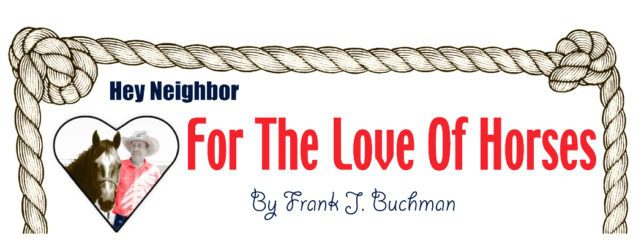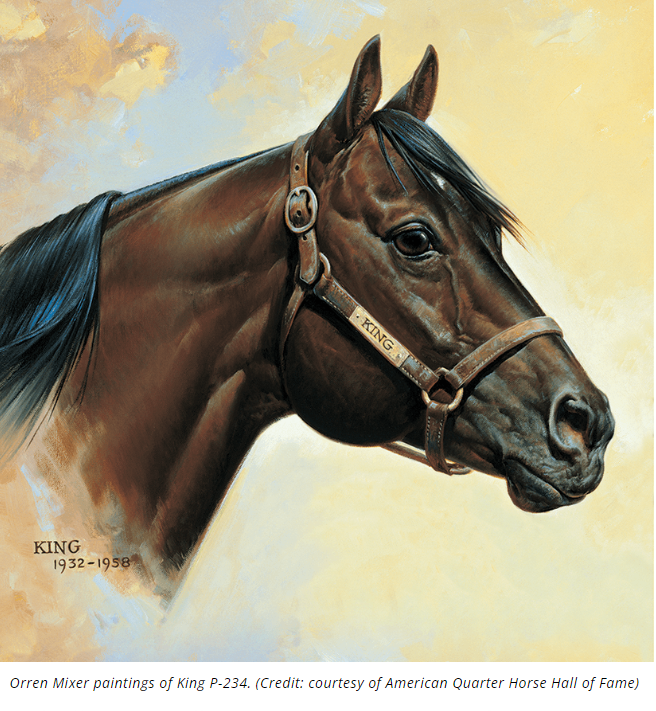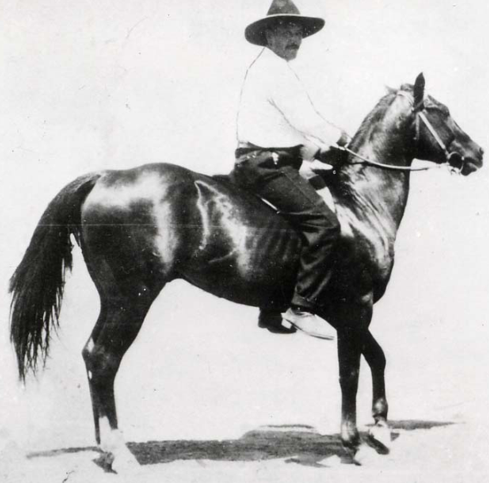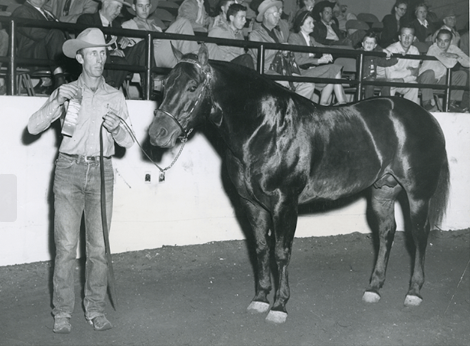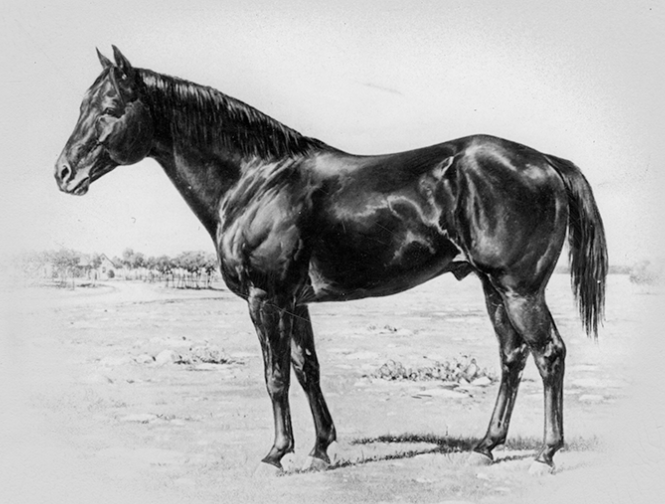“There is only one King of Quarter Horses.”
Of more than 6 million registered Quarter Horses, King P-234 is usually said with his registration number.
The “P” signifies King was permanently registered, not “tentatively” registered, during 1940s’ formation of the American Quarter Horse Association (AQHA).
According to research by renowned Quarter Horse writer Richard Chamberlain, King sired 636 registered foals that earned $156,132. That was a lot of money back then, when asking anybody still living from those days.
While he sired a few racehorses, King is best remembered for producing horses with performance ability and cow sense.
When the bay stallion died, he was on every AQHA halter and performance leading sire list. For that, King was in the first class inducted into the American Quarter Horse Hall of Fame, Amarillo, Texas, 1989.
King P-234 was bred by Manuel Volpe, Laredo, Texas, and was foaled in 1935, five years before AQHA was founded.
He is a son of the Little Joe stallion Zantanon, considered “Man O’War of Mexico,” for his racetrack exploits. Volpe also owned Zantanon, thought to be the “best” among several sons of Little Joe, who in turn was a great son of Traveler.
Zantanon was out of Jeanette by Old Billy, a son of Shiloh and out of a daughter of Steel Dust. Zantanon’s granddams on both sides were by Sykes Rondo, again going back to Old Billy through McCoy Billy.
“In other words, if Zantanon had not been a good horse, it would not have been because of his breeding,” Chamberlain surmised. “A more purple pedigree could hardly be dreamed up.
“He had the intelligence, speed, and endurance that are supposed to go with good breeding,” Chamberlain evaluated. “More importantly, Zantanon had the prepotency to endow his get with the same. Zantanon Jr, Ed Echols, and San Siemon all got their share.”
Likewise, King got more than his share. Jabalina, King’s dam, was owned by a friend of Volpe. “The friend wagered the mare against one of Volpe’s fat heifers that his pregnant wife would have a baby boy. The woman produced a girl, and Jabalina entered the Volpe’s broodmare band,” as recited by Chamberlain.
When Jabalina foaled, Volpe sold the colt for $150 to Charles Alexander, who raced the bay horse a couple times. Known then as “Buttons” was a racetrack winner.
“Buttons was only rough broke when raced. Yet he did 200 yards in :11.4-seconds,” said J.O. Hankins, early day Quarter Horseman.
Later, Byrne James, Encinal, Texas, paid $325 to become the stallion’s new owner. James’ wife Mary Elizabeth changed the colt’s name. “Buttons, I’m changing your name to King, for truly you are the king of Quarter Horses.”
James, rancher and professional baseball player, trained King for ranch work including roping. Winn Dubose offered James a profit of $225 over what he had paid for King and continued to use the four-year-old for roping.
In the meantime, Hankins (later AQHA’s 13th president), Rocksprings, Texas, had a mare he wanted to breed to a stallion of equal quality.
“When I saw King, I knew I had found the horse to whom I wanted to breed my mare,” Hankins said. “I also knew that I was going to own that stallion. He was the most magnificent horse I had ever seen.”
Dubose didn’t want to part with King and refused Hankins’ first offers, but finally sold King for $800.
A man could buy a new car, equipped with a radio and a spare tire, for less than Hankins paid for one horse. Friends predicted bankruptcy for Hankins.
One way to recoup his investment was for Hankins to increase King’s breeding fee. He stood him for $15 the first season and upped the ante to $25 the next year.
“When, the next year, Hankins raised the price to $50, there were predictions that he would lose all his business. However, the next year, he upped the price to $100 and had to turn down mares.”
The stud fee eventually reached $500. Although King was settling approximately 50 mares annually through artificial insemination, Hankins still had to refuse breeding’s.
Potential for propagation was not the only reason Hankins purchased King. The rancher was “a using-horse man through and through,” and it took a using kind of horse to work.
King acquired a reputation regionally as a sire. Squaw H was to attract the first widespread attention to King as a sire. She outran most of the horses in the country match racing, losing only to the great Shue Fly.
Other progeny added to successes. King’s daughter 89’er was a leading dam of race Register of Merit qualifiers. Royal King dominated in the cutting pens and began siring others to do the same.
Then came Poco Bueno, becoming his sire’s only rival at stud, siring Poco Lena and Poco Tivio, dominant performance sires
Tom B, Old Taylor, King’s Pistol, and Cactus King are but a few through performance and prepotency lifted King’s fame. Later generations have kept him there, including Joe Cody, Blondy’s Dude, and Peponita.
King sired a total of 648 horses, 217 of which entered AQHA performance events, with 20 becoming AQHA Champions. King’s daughters produced 50 AQHA Champions and 31 triple A (AAA) runners.
King had not been idle while all that was going on. He was grand champion at both Abilene, Texas, and San Angelo.
The bay stallion was champion stallion at Abilene, Texas, and second in cutting at Fort Worth, when retired from competition.
“King was an awful good-natured horse, a very obedient horse,” Hankins said. “He never did give me any trouble. Anybody who could lead a horse could handle King. I’d tie him right between other horses, geldings, and mares. If he acted a little fidgety, I’d just holler at him, and that’d be all of it.
“I used to turn him loose in the yard let him graze. I’d be sitting there, and he’d come by and nuzzle around, smell my coffee cup. After a while, he’d walk to the fence and look around.”
King died of a heart attack on March 24, 1958.
Many generations later, King still stands out as royalty.
